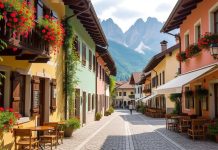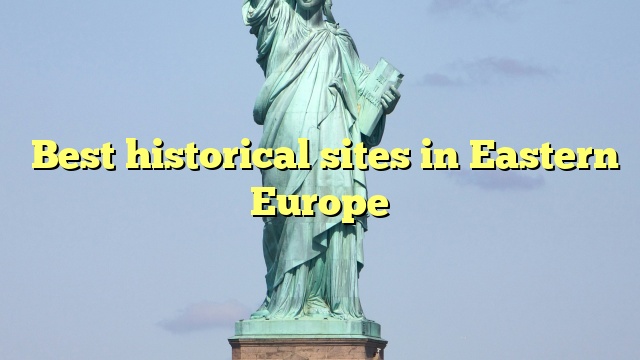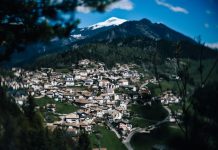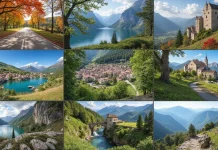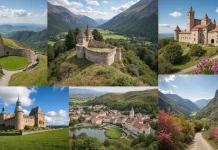Discovering the Rich History of Eastern Europe
Castles and Fortresses: Guardians of History
Bran Castle, Romania
Bran Castle, often associated with the Dracula legend, stands as one of Romania’s most visited landmarks. Nestled in the Carpathian Mountains, it is a perfect example of a medieval fortress. Built in the 14th century, the castle served as a strategic defense against invasions from the Ottoman Empire. While its Dracula connection is more legend than truth, the castle itself provides a fascinating glimpse into Romanian history with its Gothic architecture and stunning views.
Wawel Castle, Poland
Wawel Castle in Kraków is a centerpiece of Polish heritage. This magnificent structure has been the residence of kings and a symbol of Polish national identity. Featuring a blend of architectural styles from medieval, renaissance to baroque, the castle’s intricate chambers and the cathedral offer a journey through Poland’s regal past. A visit to the Wawel Dragon statue is a must, igniting the folklore that has been passed down through generations.
Bojnice Castle, Slovakia
Bojnice Castle is Slovakia’s fairy-tale fortress with its romantic turrets and picturesque setting. The castle dates back to the 12th century and has undergone renovations that added to its romantic appeal. It houses a museum displaying historical artifacts, paintings, and an underground cave. The annual International Festival of Ghosts and Spirits held here adds an eerie yet thrilling aura to its history.
Ancient Wonders: Untold Stories
Basilica Cistern, Istanbul, Turkey
Though Turkey straddles both Europe and Asia, the Basilica Cistern located in Istanbul is a gem that deserves attention. Built in the 6th century during the reign of Emperor Justinian I, this subterranean marvel was used to store fresh water for the great palace and surrounding buildings. Its massive stone columns, dim lighting, and mystical atmosphere provide an extraordinary experience for history enthusiasts.
Troy, Turkey
The ancient city of Troy, now an archaeological site in Turkey, offers a tangible connection to the epic tales of Homer. Known for its importance in the Trojan War, exploring the ruins reveals layers of history dating back to the early Bronze Age. The remnants of walls, temples, and houses provide intriguing insights into the civilizations that thrived here over millennia.
Architectural Masterpieces: A Blend of Art and Culture
St. Basil’s Cathedral, Russia
Located in Moscow’s iconic Red Square, St. Basil's Cathedral is renowned for its vibrant, onion-shaped domes and intricate patterns. Built in the 16th century by Ivan the Terrible, the cathedral commemorates the capture of Kazan and Astrakhan. Its colorful architecture and maze-like interior design reflect both Russian and Byzantine influences, making it a spectacle of historical and cultural fusion.
Parliament Building, Hungary
Budapest’s Parliament Building, one of the city's most recognizable landmarks, stands majestically along the Danube River. Completed in 1902, this Gothic Revival architectural masterpiece is not only a political hub but also a repository of Hungary’s rich history. The ornate interior features a grand staircase, a central dome, and stunning assembly halls, each narrating its own story.
World War Monuments: Echoes of the Past
Auschwitz-Birkenau, Poland
Auschwitz-Birkenau remains a solemn reminder of the horrors of World War II. Visiting this site is a profoundly moving experience that sheds light on the atrocities of the Holocaust. Preserved barracks, railway tracks, and the haunting museum exhibits serve as a poignant tribute to the many lives lost and an educational journey for future generations.
The Sarajevo Tunnel, Bosnia and Herzegovina
The Sarajevo Tunnel, also known as the Tunnel of Hope, played a crucial role during the Siege of Sarajevo in the Bosnian War. The war-torn city depended on it for supplies, communication, and transport. Today, its sections are open to visitors, offering an immersive insight into the resilience of Sarajevo’s citizens during challenging times.
Bridging Cultures: Crossroads of Civilizations
Rila Monastery, Bulgaria
Nestled in the Rila Mountains, the Rila Monastery is not only a spiritual center but a cultural icon of Bulgaria. Founded in the 10th century, this UNESCO World Heritage Site boasts stunning frescoes, historical artifacts, and intricate architecture. It embodies a melding of religious devotion and artistic expression that narrate Bulgaria's historical evolution.
Mtskheta, Georgia
Mtskheta, Georgia’s ancient capital, is a living museum of Christian history and architecture. The Svetitskhoveli Cathedral and Jvari Monastery are significant sites reflecting the acceptance of Christianity in Georgia. The town’s strategic location at the confluence of the Mtkvari and Aragvi rivers made it an important cultural and religious center in the region.
Enigmatic Old Towns: Walk Through Time
Old Town of Tallinn, Estonia
Tallinn’s Old Town is a charming journey back to the medieval era with cobblestone streets, ancient churches, and well-preserved merchant houses. The town’s towering Gothic spires and craft workshops offer a lively glimpse into Estonia's past, while the preserved medieval walls provide a literal boundary between present and past.
Dubrovnik Old Town, Croatia
Often referred to as the “Pearl of the Adriatic,” Dubrovnik’s Old Town is an extraordinary spectacle. Surrounded by imposing fortress walls, this UNESCO World Heritage Site showcases the wealth and diplomacy of its past residents. Wandering through its marble-paved streets reveals baroque buildings, historic monasteries, and elegant palaces while offering stunning views of the Adriatic Sea.
Religious Pilgrimages: Sacred Journeys
Czestochowa, Poland
Czestochowa is home to the Jasna Góra Monastery, a revered pilgrimage site attracting millions of visitors annually. The monastery houses the Black Madonna painting, believed to have miracle-working power. The devout atmosphere and architectural beauty of this sacred site offer a spiritual retreat amidst Poland's historical landscapes.
Our Lady of Medjugorje, Bosnia and Herzegovina
Since 1981, Medjugorje has been a site of pilgrimage for Catholics worldwide due to the reported apparitions of the Virgin Mary to local children. The town has since evolved into a bustling spiritual center, with visitors engaging in prayer, reflection, and participation in a variety of religious activities amidst the beautiful Herzegovinian landscape.
Industrial Heritage: Remnants of Progress
Salt Mine in Wieliczka, Poland
The Wieliczka Salt Mine, operational since the 13th century, is a testimony to industrial heritage and underground artistry. The mine’s extensive network of tunnels and chambers reveals the profound history of salt mining. Its stunning chapels, sculptures, and lakes carved from salt rock underground ranked it as one of the world's most curious wonders and a UNESCO World Heritage Site.
Saxon Villages of Transylvania, Romania
The Saxon Villages of Transylvania stand as a fascinating reminder of the region’s multicultural past. These villages, with fortified churches unique to the Saxon settlers, consist of seemingly untouched medieval houses and unique structures that narrate the interwoven experiences of Romanian, Hungarian, and Saxon nationalities.
Redefining History: Creative Transitions
The Berlin Wall, Germany
While Berlin is often associated with Western Europe, the Berlin Wall remains a pivotal historical site with influences stretching into Eastern Europe narratives. Originally a symbol of division, the remaining segments of the Wall now serve as canvases for vibrant street art. The East Side Gallery, an open-air gallery along a surviving section of the wall, symbolizes creative defiance against oppression and serves as a poignant reflection on Europe’s divided past.
Devil’s Town, Serbia
Located in the southern region of Serbia, Devil’s Town is a natural monument of peculiar rock formations. While geologically significant, folklore surrounds the formations with tales of a petrified wedding party turned to stone by the devil. The site offers unique insights into Serbia’s natural history, invoking curiosity alongside the mythical allure often found in Eastern European heritage.
Preserved Antiquity: Journey into Prehistory
Cucuteni-Trypillia Archaeological Site, Ukraine
The Cucuteni-Trypillia site, stretching across Ukraine and into Romania and Moldova, represents one of the earliest known complex societies in Europe. Known for its sophisticated pottery and large-scale settlements, the site sheds light on the Neolithic periods between 5400 to 2700 BCE. Its study offers a rare window into early human societal structures and technological advances.
Vinca Culture, Serbia
The Vinca archaeological site near Belgrade is a treasure trove of early European civilization, dating back to 5700 BCE. Known for its anthropomorphic figurines and early forms of writing, the Vinca culture challenges modern perceptions of prehistoric development. The site allows visitors to experience firsthand discoveries that puzzle archaeologists even today.
Forgotten Paths: Rediscovering Legends
Transfagarasan Highway, Romania
Designed as a strategic military route during the Cold War, the Transfagarasan Highway winds through the dramatic landscapes of the Carpathian Mountains. This engineering marvel is now celebrated for its breathtaking scenic drives, offering glimpses of ancient and natural wonders while delving into Romania’s strategic historical narratives.
Lazar Canyon, Serbia
Lazar Canyon, one of the deepest canyons in Eastern Europe, holds a mystique wrapped in history and breathtaking natural beauty. Once a refuge for outlaws and monks alike, the canyon’s sheer cliffs and cave systems tell tales of resistance and spirituality. A trek through its rugged paths connects adventurers with legends and exceptional biodiversity unique to the Balkan region.
Epilogue of an Era: Revisiting Modern History
Ploiesti Oil Fields, Romania
During World War II, the oil fields of Ploiesti played a crucial role as the main supplier of oil for the Nazi regime. Targeted by numerous Allied bombings, these fields were central to much wartime strategy. Today, visiting Ploiesti gives insight into the conflict's industrial dimensions and the broader impacts of war on natural resources and regional development.
Cold War Relics, Czech Republic
The landscape of the Czech Republic is dotted with remnants from the Cold War era, including abandoned military bunkers and Soviet-era architecture. These serve as tangible memories of life under the influence of the Iron Curtain. Exploring these relics offers poignant insights into the socio-political landscape of the mid-20th century and the eventual transition towards modern democratic society.
Historians, architects, and travelers can immerse themselves in the wealth of Eastern Europe's historical tapestry. From its medieval fortresses to modern tales of unity and transformation, the myriad sites offer an evocative reflection of a region rich with stories, each unraveling unique cultural narratives spanning centuries. Explore these locales, witness history come to life, and appreciate the resilience and beauty of Eastern Europe's tangled past.


